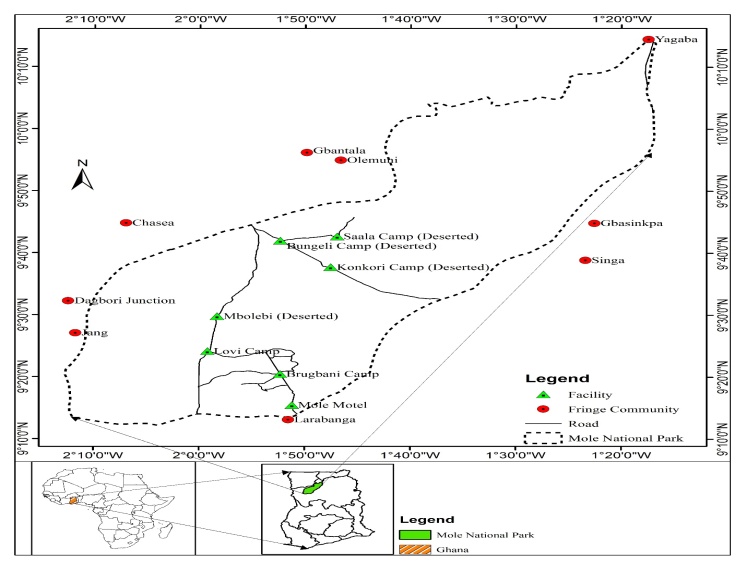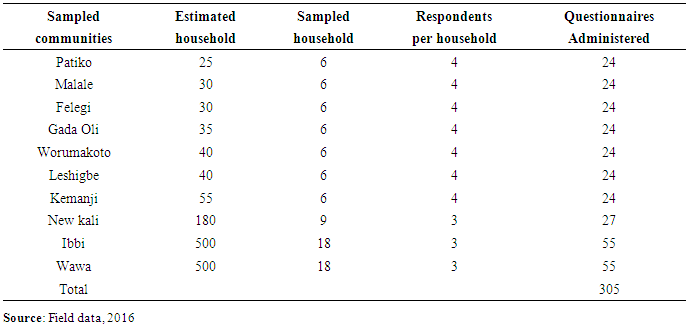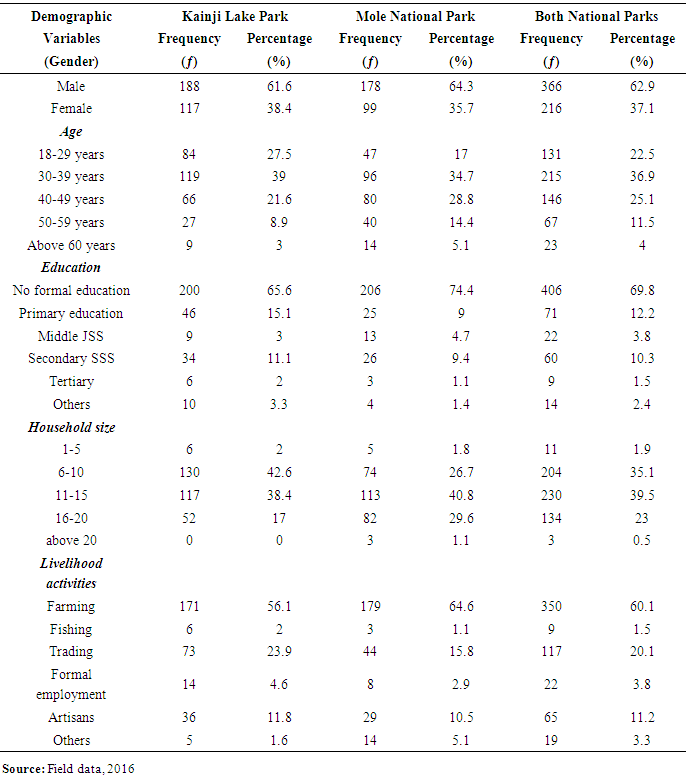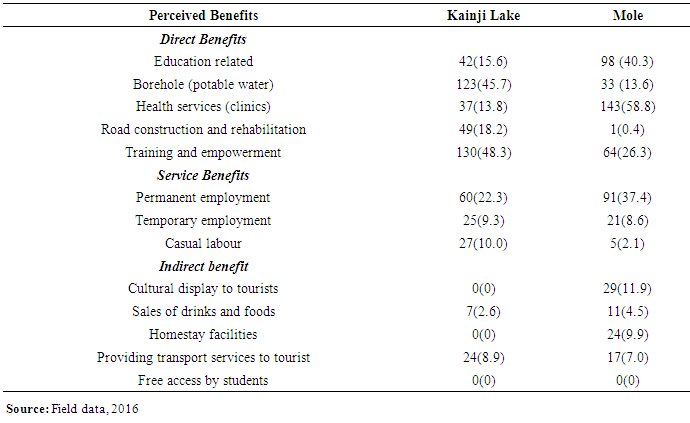-
Paper Information
- Paper Submission
-
Journal Information
- About This Journal
- Editorial Board
- Current Issue
- Archive
- Author Guidelines
- Contact Us
American Journal of Tourism Management
p-ISSN: 2326-0637 e-ISSN: 2326-0645
2019; 8(1): 8-18
doi:10.5923/j.tourism.20190801.02

Perceptions on Benefits of Ecotourism Development by Residents of Fringe Communities to Two National Parks in West Africa
Folusade C. Arowosafe1, Kuuder Conrad-J. Wuleka2, Entsua-Mensah M. Rose Emma3
1Department of Ecotourism and Wildlife Management, Federal University of Technology, Akure, Nigeria
2Department of Ecotourism and Environmental Management, University for Development Studies, Nyankpala Campus, Ghana
3Council for Scientific and Industrial Research, Ghana
Correspondence to: Kuuder Conrad-J. Wuleka, Department of Ecotourism and Environmental Management, University for Development Studies, Nyankpala Campus, Ghana.
| Email: |  |
Copyright © 2019 The Author(s). Published by Scientific & Academic Publishing.
This work is licensed under the Creative Commons Attribution International License (CC BY).
http://creativecommons.org/licenses/by/4.0/

Fringe communities in protected areas (national parks) are thought to benefit immensely from ecotourism development emanating from such facilities. This study sought to assess the perceived benefits of ecotourism development in nearby communities to two West African national parks namely: Kainji Lake National Park (KLNP) in Nigeria and Mole National Park (MNP) in Ghana. Stratified random sampling was used in selecting 10 households each in both countries. A total of 582 respondents were contacted through semi-structured questionnaires while key informant interviews including focus group discussions were used to obtain data on the direct, indirect and service benefits. Data analysed suggests that at KLNP, the provision of boreholes (45.7%) was the most cited direct benefit whereas 58.8% of respondents to communities adjacent MNP cited provision of health services. The indirect benefits revealed at KLNP were that residents had the opportunity to provide transport services to tourists, while at MNP, residents had an opportunity to display culture at a fee and sell arts and craft to visiting tourists. Service benefits unveiled in the study relate more of employment generation through ecotourism in both parks. A “needs assessment” survey of “flanking” communities is recommended as an appropriate measure to bridging the gap between what benefits the residents need and why such benefits should give the needed impetus to support conservation efforts in both parks.
Keywords: Nigeria, Ghana, Protected Areas, National Parks, Ecotourism, Conservation, Kainji Lake National Park, Mole National Park
Cite this paper: Folusade C. Arowosafe, Kuuder Conrad-J. Wuleka, Entsua-Mensah M. Rose Emma, Perceptions on Benefits of Ecotourism Development by Residents of Fringe Communities to Two National Parks in West Africa, American Journal of Tourism Management, Vol. 8 No. 1, 2019, pp. 8-18. doi: 10.5923/j.tourism.20190801.02.
Article Outline
1. Introduction
- It is a well-known fact that since creation, man has always lived in harmony with nature because he draws his sustenance from natures’ “fruits”. Nonetheless, the fast pace at which human population has grown now is the reason for an over dependence on the resources of the earth. This phenomenon poses a threat to resource conservation and in that light, governments and conservationists in many countries of the world have enacted laws and policies aimed at the conservation of these resources, (especially wildlife) for posterity reasons. Indeed, nations that abound in such natural resources will be doomed in their conservation efforts without stakeholders finding alternative strategies to enable the communities that live with wildlife resources in particular benefit from its use. One such strategies that has been promoted to support conservation and also as an avenue for creating job opportunities and to generate income for residents living in communities adjacent Protected Areas (PAs) especially National Parks is the development of ecotourism [12]. Ecotourism, generally seen as an opportunity for development of rural communities, gives rural dwellers an occasion to participate in the conservation of fragile but threatened areas including endangered species [23,25]. Indeed, rural areas also need development interventions and if stakeholders implement such assistance strategically and convincingly where the benefits are clearly spelled out, local residents are more likely to bring to bear their endogenous knowledge on conservation to make it a success. National parks according to [21] have the potential to provide various opportunities to the communities living around them through provision of benefits such as employment, increased social contacts, improved livelihoods and community development.The perception of local residents who live on the fringes of famed parks in particular is extremely relevant in conservation related efforts. This has been explained further in the literature that, the success of the development of a PA can be measured in terms of the extent to which nature is effectively conserved as well as the perception of benefits obtained by the local residents living in communities that surround these protected areas [31,24,4,28]. Several approaches exist for conservation related efforts in PAs, but effective conservation of parks for instance is achieved basically employing two main approaches [2]: one such approach is to employ the preservation approach, aimed at setting aside national parks to exclude human activities except when tourism related use becomes the philosophy. Through this approach, direct use of natural resources in the park for commercial or subsistence purposes is prohibited.The other ‘tactic’, the community-based conservation approach, very often, is proposed to address problems associated with excluding human activities from the park [27]. The community-based conservation approach which involves initiatives aimed at conserving biodiversity in parks is also further geared towards enabling local people benefiting from the park facility [26]. Some other initiatives involved in the community-based conservation approach include signing of resource use agreements such as in the case of the Rwenzori Mountains National Park which grants permission to local people “neighbouring” national parks to access specific resources from the facility for their subsistence purposes [33].In Nigeria, the Nigerian Conservation Foundation and the Nigerian Game Reserve Authorities are “charged” with the responsibilities of wildlife conservation projects. Of relevance is also to mention that the KLNP is under management of the Federal National Parks Service (FNPS) receiving direct funding from government sources. In 2001, for instance, the Nigerian National Parks generated a total of about three million dollars through ecotourism and entertainment and this makes conserving PAs a gesture worth the effort in that country (source:www.iucnael.org/en/documents/701...wildlife-conservation-and... management.../file). The Wildlife Division of the Forestry Commission of Ghana on the other hand is also responsible for the management and protection of PAs in Ghana and has been keenly interested in the activities at the two most popular national parks in Ghana, ie Kakum National Park (most popular in terms of visits) and Mole National Park (most popular in terms of animal stock). The Kakum National Park for instance in Ghana’s Central Region established in 1992 has a three-fold mission: to protect biodiversity, to develop tourism and to improve the livelihood of the fringe communities [3].Other examples include a scenario whereby local people are given money for infrastructural development, such as in Integrated Conservation and Development Initiative in Korup National Park in Cameroon [16]. In other National Parks (see [36], on Pendjari National Park, in Benin), local people are given a percentage of revenue generated from tourism activities in the park all in the effort of enticing them to embrace conservation for the longevity of such park facilities.The rich biodiversity potentials of Africa has indeed attracted numerous ecotourists, holiday seekers and/or vacationers from other countries interested in visiting tropical landscape, engaging in game viewing and learning about or immersing themselves in local cultures [9]. In both Nigeria and Ghana, as well as other developing countries of the world, local communities, have always depended on their natural resources as a source of livelihood, with these “assets” providing benefits and related services, ranging from provision of food, water, herbal medicine, fodder for livestock, raw materials for craftwork including other cultural services such as recreation, [34]. Thus the dependence on natural resources and products from the environment according to [35] is considered to be critical to the sustainable livelihood of local people in particular who live near PAs.It is a truism that the creation of PAs and their associated benefits oftentimes come with some painful but necessary sacrifices, ie some forms of restrictions of access to forest resources are put on the local communities who live within and adjacent to these resources leading to economic losses [5]. The irony realized in this whole mêlée however is that, in most developing countries, the local communities who often are affected by these restrictions are generally poor. They are largely also noted to derive their livelihood from these very forest resources to which they have been dispossessed of [3]. The most cited “gimmick” touted to persuade local people many a time is that; tourism will be introduced, which will be the hub of local economic activities [3].In a similar genre, tourism when introduced brings about high hopes among the local populace, ie the panacea, an economic, social and environmental “cure all”. Does the introduction of tourism/ecotourism serve beneficial purposes all the time especially to many of the issues hinging on livelihood enhancements? Meanwhile there is also a lack of convincing empirical evidence to justify the claim that increased tourism/ecotourism development will lead to significant benefits for the local poor in particular [7]. It is in the context of this scenario that this study, coming at this time and delving into the perceptions of residents of fringe communities to national parks namely the Kainji Lake National Park (Nigeria) and the Mole National Park (Ghana) is considered germane, especially coming at a time where these perceived benefits have always come from the perspectives of conservation related stakeholders but not from those who live with these resources, hence the necessity of the study.
2. Problem Statement
- The economies of both Nigeria and Ghana are heavily depended on the export of natural resources (both renewable and non-renewable), such as oil, cocoa, timber and in more recent times have veered into service oriented industries such as tourism. It has been noted in the literature that, most rural dwellers in Africa (the two countries inclusive), especially in rural communities adjacent to national parks, still utterly rely on subsistence farming whilst also drawing from what their immediate natural environments can provide such as bush meat, fruits, fuelwood, fish, herbs, and housing materials [1] When this source of livelihood sustenance is taken away through the establishment of PAs, it becomes a difficulty for the local people to find alternative support for the sustenance of their families and other dependants. The very survival of such PAs are therefore thrown into a state of limbo especially if the park’s creation and or development related activities have negatively impacted on their traditional sources of livelihood [17]. It is only when other alternative benefits begin to come their way that the local people often tend to appreciate the relevance of such conservation related initiatives. Despite the fact that benefits may also accrue to the local people from ecotourism related activities in fringe communities, it is also a truism that the distribution of such benefits may in the end pose a problem, especially when clique systems become the order of the day with a privilege few (elite) being the ultimate recipients to the displeasure of the less powerful majority. Thus, the Social Exchange Theory (SET) oftentimes has proven to be a suitable theoretical framework for analysing residents’ perceptions of and attitudes toward tourism development [19]. SET is based on the disciplines of psychology, economics and sociology and as such is suitable in this particular area of tourism research where resident’s perceptions are being explored. Its psychological philosophies explain why human beings by nature will engage in social relations and interaction anticipating potential benefits rather than risks and once the risks outweigh the benefits, they are likely to terminate the relationship. It is therefore generally suggested that residents who perceive tourism to be personally valuable and believe that the costs associated with tourism does not exceed the benefits will likely show a greater support for tourism development [19]. Conversely, should local communities perceive the costs of tourism to outweigh the benefits, they will withdraw their support for tourism [29]. The study therefore posed the following research questions: What are the perceived benefits of ecotourism development in the PAs to the local fringe communities in both countries? and to what extent have their expectations been met while embracing ecotourism development?
3. Methodology
- Study AreaThe study covers communities flanking two national parks in West Africa, Kainji Lake National Park, (KLNP in Nigeria) and Mole National Park (MNP in Ghana). The two national parks are in category II according to the categorization of International Union for the Conservation of Nature (IUCN). These are usually large, natural or near natural areas set aside to protect large-scale ecological processes, along with the complement of species and ecosystems characteristic of the area, which also provide a foundation for environmentally and culturally compatible spiritual, scientific, educational, recreational and visitor opportunities [32].
3.1. Kainji Lake National Park (Profile)
- The Kainji Lake National Park (KLNP) was established in 1979 by the merger of two non-contiguous sectors: the Zugurma Sector (1,370 km2) and Borgu Sector (3,970 km2). The KLNP is located on the boundary between the north of the Guinea Savannah and south of the Sudan Savannah vegetation zones, which is rich in biodiversity of plant and animal species. It is located between latitude 9°40’N and 10°30’ and longitude 3°30’N and 5°50’ and has a total land mass of 5,340.82km2.
 | Figure 1. Location of Kainji Lake National Park in Nigeria (West Africa) |
 | Plate 1. Hippos and Lions in KLNP (Source: http://www.nigeria-direct.com/activity/find -the-big-5-at-lake-kainji-national-park-one-of-the-largest-game-reserves-in-west-africa) |
3.2. Mole National Park (Profile)
- Mole National Park is located in Northwestern Ghana on grassland savanna and riparian ecosystems at an elevation of 150 m, with sharp escarpment forming the southern boundary of the park. It is situated between Wa and Tamale (both towns being regional capitals in northern Ghana) and lies between 9°11’ and 10°10’ N, and between 1°22’ and 2°13’ W, [22]. In 1971, the facility was gazetted as a National Park under the Wildlife Reserve Regulations, for its outstanding wildlife and also to protect its habitat. Its area was enlarged to 4,554km² by extending the boundaries north to the Kulpawn River area and eastward over the Konkori escarpment. In 1992, the park area was further enlarged to its present size of about 4577 km² with the addition of the Gbantala triangle (see Figure 2) onto the locational map of MNP in the northern region of Ghana.
 | Figure 2. Map of Mole National Park indicating its location in Ghana (West Africa) |
 | Plate 2. Elephants and Buffolos in MNP (Source: https://visitghana.com/attractions/mole-national-park-2/) |
3.3. Sampling and Data Collection
- There are in all twenty-one (21) fringe communities to KLNP whilst on the Ghana side, thirty-three (33) communities flank MNP. Ten (10) communities were purposively selected for the purpose of the study from each of the national park area. The criterion used was to select the communities that were of close proximity to each of the park than those that were far flank off. In each community, the chief’s palace was the first call point, introductions made after which the research mission and objectives were explained. Information for the study was sourced through interview schedules including employing questionnaire administration. For data collection in the selected communities, three (3) research assistants based in either of the park areas in both countries and who were trained earlier, doubled as interpreters and read the questions from the questionnaire to the respondents in their native language, their responses elicited and written in the spaces provided [19]. This was done due to the high level of illiteracy among the residents.A total of five hundred and eighty-two (582) respondents comprising (305) at communities of Kainji Lake National Park (see Table 1) and two hundred and seventy-seven (277) at communities of Mole National Park were involved in the survey (see Table 2) employing the use of questionnaire. Before the research begun in the selected communities, a survey of the number of households in each community was done. Two communities at the KLNP area namely Ibbi and Wawa had an estimated 500 household size each while the least size was noted at Patiko with 25 households. At the MNP area, the ancient town of Larabanga also had an estimated household size of 500 with the community with the least population size being Kananto which had 30 households (see Table 2). With the use of the questionnaire, the perceived benefits were put into three themes namely: direct, service and indirect benefits. In accordance to these themes, responses were sought for the purpose of analysis.
|
|
3.4. Research Design
- The research design adopted for this study is that of the comparative design. One of the more obvious forms of such research is in cross-cultural or cross-national research (7). In a useful definition, Hantrais (1996) cited by (7), has suggested that “such research occurs when individuals or teams set out to examine particular issues or phenomena in two or more countries with the express intention of comparing their manifestations in different socio-cultural settings (institutions, customs, traditions, value systems, lifestyles language and thought-patterns), using same research instruments either to carry out secondary analysis of national data or to conduct new empirical work. The aim may be seek explanations for similarities and differences or to gain a greater awareness and a deeper understanding of social reality in different national contexts” (7, p.65).The results that were then collated were analyzed quantitatively based on local people’s perceptions about ecotourism related benefits in the national park areas where they lived by.
4. Results and Discussions
- Socio-demographic characteristics of Respondents of the fringe CommunitiesResults obtained as shown in Table 3 revealed more male respondents than females in the study communities at the two National Parks. At KLNP communities, findings shows 61.6% of the respondents were male while at MNP communities, 64.3% of the respondents were male. Results from the survey again revealed that the highest age incidence at both park communities “converged” at the age range 30-39years, with 39% for KLNP fringe communities and 34.7% for MNP communities.
|
|
5. Conclusions
- It came up in the study that most residents in these fringe communities to the two national parks were illiterate (no formal education). They also depended heavily on the resource until both facilities were designated national parks and a main source of livelihood (farming and hunting) were taken off. Such situations often called for interventions to enable locals find alternative sources of livelihood, one such ways was to let them benefit from tourism related activities in the parks and other relevant development intervention projects.This study has been able to establish that although, some of the communities had benefited from some park and NGO intervention programmes such as the provision of boreholes, agricultural extension services, health services, and some levels of formal employments, such benefits were however found to be inadequate and not universally distributed in the fringe communities of both parks.
6. Recommendations
- 1. The study revealed that 45% of Kainji area communities benefited from potable water provision while only 13% in the Mole area communities also benefited. This therefore calls on stakeholders, park management and governments of the two nations to put in more efforts at water provision and make it a priority since it is a basic need.2. Development of road infrastructure leading to the national parks and adjacent communities especially those used within communities could be expanded, upgraded with gravel and regularly maintained to allow the communities gain easy access to market, health facilities and other services available in other communities and the parks. This will add to the stock of benefits amassed by the communities.3. Training and extension related opportunities in agriculture since the park cannot offer every citizen formal employment. Such trainings should be annual and extended to benefit many more of the communities since it will offer locales of the fringe communities brighter agricultural prospects.4. Homestay opportunities should be expanded in the Mole area while such opportunities should also be introduced in the Kainji area to bring more tourism benefits to the door-step of the fringe communities.5. A needs assessment is also recommended periodically to ascertain the benefits expected by the community residents and conscious efforts made by park management to provide what these residents ask for. This will give them the needed zeal to embrace conservation efforts championed by the parks.
 Abstract
Abstract Reference
Reference Full-Text PDF
Full-Text PDF Full-text HTML
Full-text HTML


